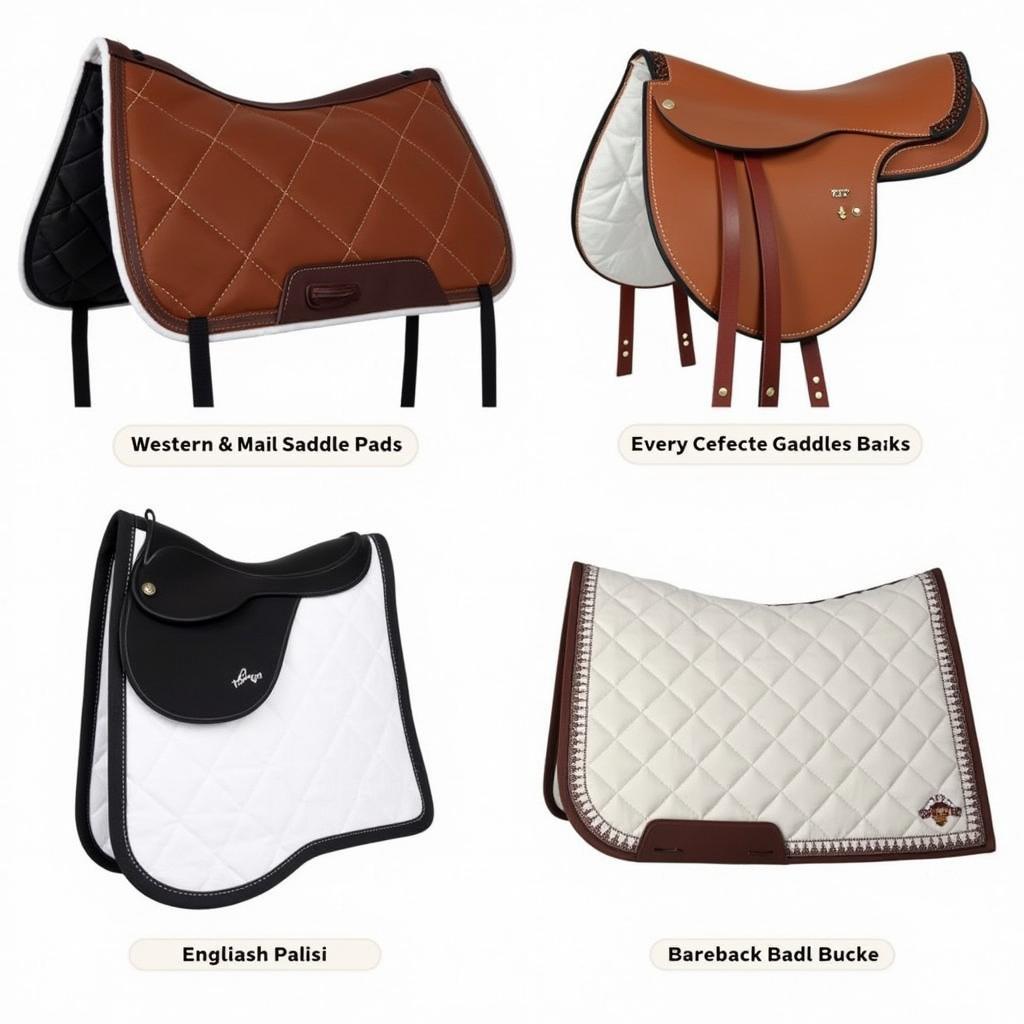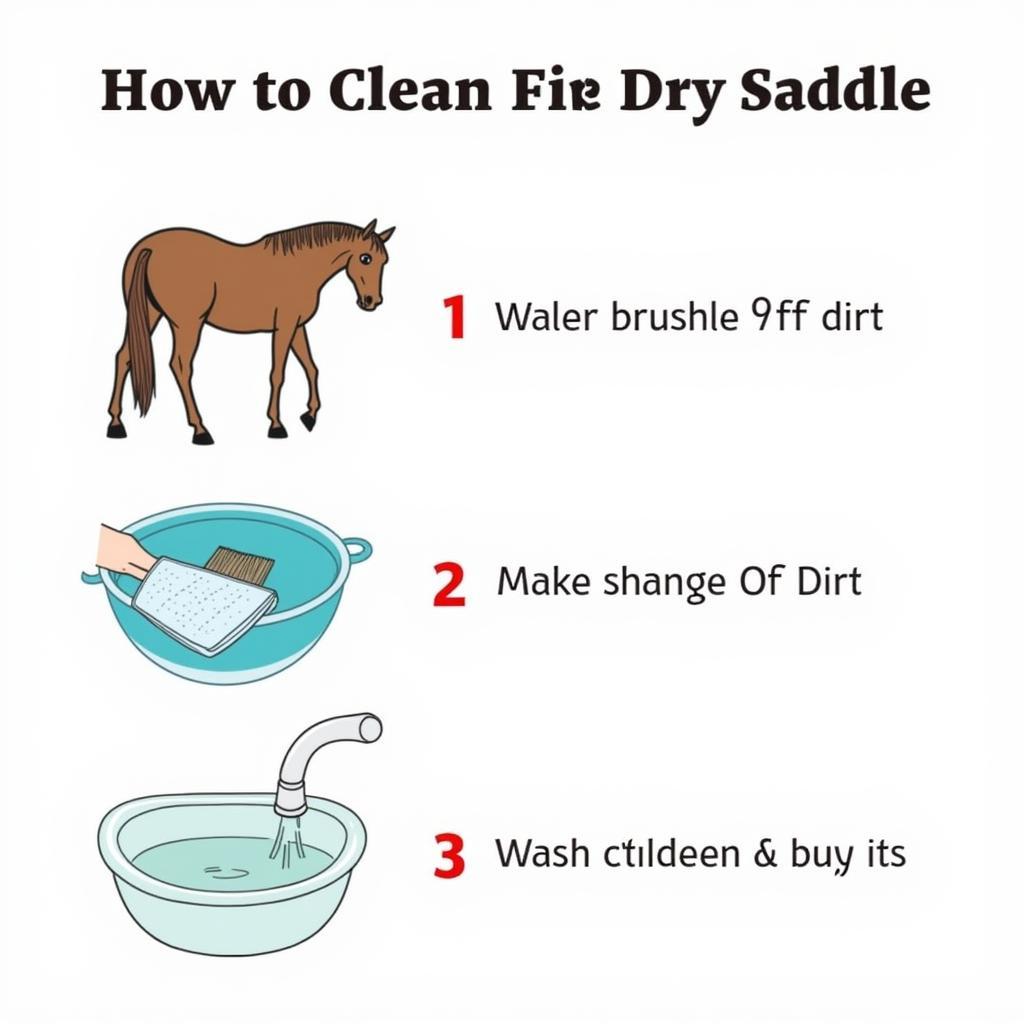Choosing the Best Horse Saddle Pads is crucial for your horse’s comfort and performance. A saddle pad acts as a buffer between the saddle and your horse’s back, absorbing shock, preventing rubs, and wicking away moisture. With countless options available, finding the perfect saddle pad can feel overwhelming. This comprehensive guide will equip you with the knowledge to make an informed decision, ensuring your equine partner enjoys a comfortable and enjoyable ride.
 Different Types of Saddle Pads
Different Types of Saddle Pads
Understanding the Importance of Saddle Pads
Before delving into the specifics of choosing the best horse saddle pads, it’s essential to understand their significance. Imagine carrying a heavy load on your back without any cushioning – uncomfortable, right? That’s precisely what it’s like for your horse without a proper saddle pad. Here’s why they’re indispensable:
- Shock Absorption: Riding, especially at faster gaits or over rough terrain, involves significant impact. A quality saddle pad absorbs these shocks, protecting your horse’s back from jarring and potential injury.
- Pressure Distribution: Even with a well-fitted saddle, pressure points can arise. Saddle pads help distribute the rider’s weight and the saddle’s pressure more evenly across the horse’s back, minimizing discomfort.
- Friction Reduction: The movement of the saddle against the horse’s coat can cause friction, leading to rubs and sores. Saddle pads act as a barrier, reducing friction and protecting your horse’s sensitive skin.
- Moisture Management: Horses naturally sweat, especially during exercise. Saddle pads, particularly those made from moisture-wicking materials, help absorb and wick away sweat, keeping your horse dry and comfortable.
Factors to Consider When Choosing a Saddle Pad
Selecting the best horse saddle pads for your equine partner involves considering several factors. Remember, a pad is not a one-size-fits-all solution.
- Saddle Type: Western saddles require different pads than English saddles. Western pads are typically thicker and wider, conforming to the shape of the saddle, while English pads are thinner and come in various shapes to accommodate different disciplines.
- Horse’s Back Conformation: Just like humans, horses have unique body shapes. Assess your horse’s back for any high points, dips, or sensitivities. Consider pads with additional padding or shims to address these specific needs.
- Riding Discipline: The demands of different riding disciplines necessitate different types of saddle pads. For instance, endurance riding requires pads with exceptional breathability and moisture-wicking properties, while dressage pads are often shaped to highlight the saddle’s elegance.
- Material and Construction: Saddle pads are crafted from various materials, each offering unique benefits. Natural fibers like wool provide excellent cushioning and breathability, while synthetics like neoprene excel in shock absorption and durability.
- Fit and Size: A well-fitting saddle pad should lie smoothly beneath the saddle without bunching, wrinkling, or extending beyond the saddle’s edges. Refer to sizing charts and consider your saddle’s shape when selecting a pad.
 Checking Saddle Pad Fit
Checking Saddle Pad Fit
Types of Saddle Pads: Exploring the Options
The market offers a vast array of saddle pads, each designed for specific purposes. Here’s a breakdown of common types:
- Western Saddle Pads: These pads are generally thicker than English pads and come in various shapes, including square, rounded, and contoured. They are designed to accommodate the larger, heavier Western saddles and provide ample cushioning for both horse and rider.
- English Saddle Pads: Available in a multitude of shapes and thicknesses, English saddle pads cater to various disciplines. Dressage pads, all-purpose pads, and jumping pads are a few examples, each with its unique design to suit the specific riding style.
- Bareback Pads: As the name suggests, bareback pads are used without a saddle, providing a layer of cushioning and grip for the rider. They are an excellent option for casual riding or introducing beginners to horseback riding.
Caring for Your Saddle Pads: Tips for Longevity
Proper care is essential to extend the lifespan of your saddle pads and ensure they continue to perform optimally.
- Regular Cleaning: After each ride, brush off any dirt or debris from your saddle pad. Regularly wash it according to the manufacturer’s instructions.
- Proper Drying: Allow your saddle pad to air dry thoroughly after washing. Avoid using a dryer, as excessive heat can damage the materials.
- Storage: Store your saddle pads in a clean, dry place when not in use. Protect them from direct sunlight, which can fade colors and weaken materials.
 Cleaning a Horse Saddle Pad
Cleaning a Horse Saddle Pad
Choosing the Right Pad: A Worthy Investment
Investing in the best horse saddle pads is an investment in your horse’s well-being and your riding experience. A well-chosen pad can make a world of difference in your horse’s comfort, performance, and overall health. Remember to assess your individual needs, consider the factors outlined above, and choose a reputable brand known for quality and durability.
Frequently Asked Questions About Horse Saddle Pads
Here are answers to some common questions about horse saddle pads:
Q1: How often should I replace my horse’s saddle pad?
A: The lifespan of a saddle pad depends on usage and care. However, inspect it regularly for signs of wear and tear, such as thinning, rips, or compressed filling. Consider replacing it every 1-2 years or sooner if significant wear is evident.
Q2: Can I use the same saddle pad for different horses?
A: While it might seem economical, it’s best to avoid using the same saddle pad for multiple horses. This practice can transfer dirt, bacteria, and potential skin conditions between animals.
Q3: How do I know if my horse’s saddle pad fits correctly?
A: A well-fitting saddle pad should lie smoothly beneath the saddle without any bunching or wrinkles. It should be positioned to provide adequate coverage without extending beyond the saddle’s edges.
Q4: What are the benefits of using a contoured saddle pad?
A: Contoured saddle pads are designed to follow the natural curve of the horse’s back, providing a more anatomical fit and enhanced pressure distribution.
Q5: Can I wash my horse’s saddle pad in a washing machine?
A: Check the manufacturer’s instructions, as some saddle pads are machine washable while others require hand washing. Always use a mild detergent and avoid harsh chemicals.
Need More Help?
Do you have more questions about horse tack and equipment? Check out our selection of horse tack on sale or browse our horse christmas gifts collection for great ideas. Looking for the perfect gift for the horse lover in your life? Explore our curated selection of horse riding presents.
For personalized advice, contact us at Phone Number: 0772127271, Email: [email protected], or visit our address: QGM2+WX2, Vị Trung, Vị Thuỷ, Hậu Giang, Việt Nam. Our dedicated customer support team is available 24/7 to assist you.